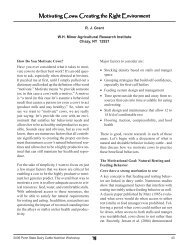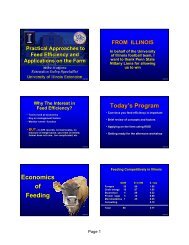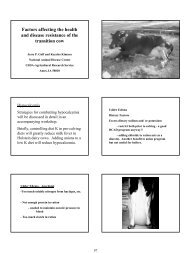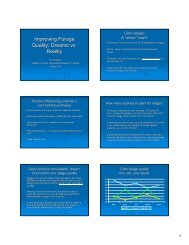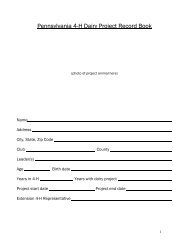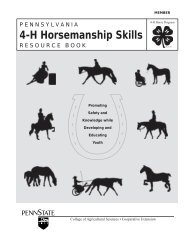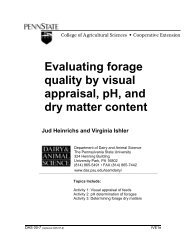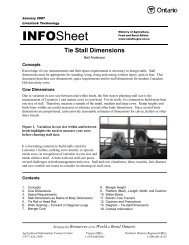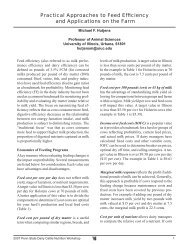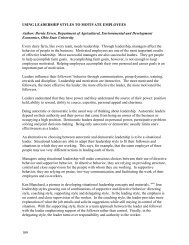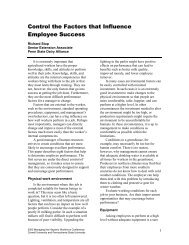Mycotoxins - Penn State University
Mycotoxins - Penn State University
Mycotoxins - Penn State University
Create successful ePaper yourself
Turn your PDF publications into a flip-book with our unique Google optimized e-Paper software.
<strong>Mycotoxins</strong>:<br />
Managing a Unique<br />
Obstacle to Successful<br />
Dairy Production<br />
Lon W. Whitlow<br />
North Carolina <strong>State</strong> <strong>University</strong><br />
Raleigh<br />
Mycotoxin:<br />
Poison<br />
Produced By<br />
Molds<br />
(Filamentous Fungi)<br />
The Mycotoxin<br />
Blue Book<br />
Nottingham <strong>University</strong><br />
Press<br />
Edited by<br />
Dr. Duarte Diaz<br />
<strong>Mycotoxins</strong> are a diverse group of fungal metabolites<br />
(chemicals produced by a mold) that cause an<br />
undesirable effect in exposed animals.<br />
SUMMARY<br />
Contact:<br />
CAST<br />
Council for Agricultural<br />
Science and Technology<br />
4420 W. Lincoln Way<br />
Ames, Iowa 50014<br />
Telephone<br />
515-292-2125<br />
Report # 139<br />
1. <strong>Mycotoxins</strong> are prevalent in feeds<br />
2. <strong>Mycotoxins</strong> are toxic to dairy cattle<br />
3. High levels cause acute effects in cattle, including death<br />
4. Low levels cause the greatest economic loss - chronic<br />
losses in milk production & more disease<br />
5. <strong>Mycotoxins</strong> can be the root cause<br />
of health and production problems.<br />
6. Prevention is important<br />
7. Treatments are effective<br />
Primary Toxigenic Molds and <strong>Mycotoxins</strong><br />
* Those Thought Most Prevalent and Toxic to Dairy Cattle<br />
Fusarium<br />
*Deoxynivalenol<br />
*Zearalenone<br />
*T-2 Toxin<br />
*Fumonisin<br />
Moniliformin<br />
Nivalenol<br />
Diacetoxyscirpenol<br />
Butenolide<br />
Neosolaniol<br />
Fusaric Acid<br />
Fusarochromanone<br />
Wortmannin<br />
Aspergillus<br />
*Aflatoxin<br />
Ochratoxin<br />
Sterigmatocystin<br />
Fumitremorgens<br />
Fumigaclavines<br />
Fumitoxins<br />
Cyclopiazonoic Acid<br />
Gliotoxin<br />
Alternaria Claviceps<br />
Stachybotrys AAL toxin Ergots<br />
Stachybotryotoxin Lupinosis Fescue Alkaloids<br />
Penicillium<br />
Ochratoxin<br />
*PR Toxin<br />
Patulin<br />
Roquefortine C<br />
Mycophenolic Acid<br />
Penicillic Acid<br />
Citrinin<br />
Penetrem<br />
Cyclopiazonic Acid<br />
1
Primary Toxigenic Molds and <strong>Mycotoxins</strong><br />
* Those Thought Most Prevalent and Toxic to Dairy Cattle<br />
Fusarium<br />
*Deoxynivalenol<br />
*Zearalenone<br />
*T-2 Toxin<br />
*Fumonisin<br />
Moniliformin<br />
Nivalenol<br />
Diacetoxyscirpenol<br />
Butenolide<br />
Aspergillus<br />
*Aflatoxin<br />
Ochratoxin<br />
Sterigmatocystin<br />
Fumitremorgens<br />
Fumigaclavines<br />
Fumitoxins<br />
Cyclopiazonoic Acid<br />
Gliotoxin<br />
Penicillium<br />
Ochratoxin<br />
PR Toxin<br />
Patulin<br />
Penicillic Acid<br />
Citrinin<br />
Penetrem<br />
Cyclopiazonic acid<br />
Known Postulated<br />
Mold Species 1,100 1,500,000<br />
Secondary Metabolites 3,200 3,000,000<br />
Neosolaniol <strong>Mycotoxins</strong><br />
Fusaric Acid<br />
Fusarochromanone<br />
Wortmannin<br />
> 300 30,000<br />
Alternaria Claviceps<br />
Stachybotrys AAL toxin Ergots<br />
Stachybotryotoxin Lupinosis Fescue Alkaloids<br />
Do mycotoxins also assist fungi<br />
to infect animals?<br />
Fungal infections in animals are termed mycoses.<br />
Fungal pneumonia, abortions, mastitis and intestinal infections<br />
Animals resist mycoses unless immune suppressed.<br />
<strong>Mycotoxins</strong> produced by fungi cause immune suppression,<br />
and thus may assist fungi in infecting animals.<br />
Hemorrhagic bowel syndrome<br />
Caused by A. fumigatus<br />
Forsberg<br />
Do mycotoxins also assist fungi<br />
to infect animals?<br />
Fungal infections in animals are termed mycoses.<br />
Fungal pneumonia, abortions, mastitis and intestinal infections<br />
Animals resist mycoses unless immune suppressed.<br />
<strong>Mycotoxins</strong> produced by fungi cause immune suppression,<br />
and thus may assist fungi in infecting animals.<br />
In studies of A. fumigatus<br />
infections in ruminants,<br />
gliotoxin and/or T-2 toxin, which are<br />
both potent immune suppressing<br />
mycotoxins, were always present,<br />
when analysed.<br />
A mycotoxin binder may prevent HBS<br />
Hemorrhagic bowel syndrome<br />
Caused by A. fumigatus<br />
Forsberg<br />
Why do fungi produce mycotoxins?<br />
As a secondary metabolite, mycotoxins have no direct<br />
function in fungal metabolism.<br />
John Deere Co.<br />
Main theories for their production are:<br />
1. Protection of the fungus<br />
2. Assist the fungus in creating an<br />
environment for survival and growth.<br />
Do mycotoxins also assist fungi<br />
to infect animals?<br />
Fungal infections in animals are termed mycoses.<br />
Fungal pneumonia, abortions, mastitis and intestinal infections<br />
Animals resist mycoses unless immune suppressed.<br />
<strong>Mycotoxins</strong> produced by fungi cause immune suppression,<br />
and thus may assist fungi in infecting animals.<br />
In studies of A. fumigatus<br />
infections in ruminants,<br />
gliotoxin and/or T-2 toxin, which are<br />
both potent immune suppressing<br />
mycotoxins, were always present,<br />
when analysed.<br />
Hemorrhagic bowel syndrome<br />
Caused by A. fumigatus<br />
Forsberg<br />
Mycotoxin Occurrence and Concentrations in Feeds<br />
From North Carolina Producers Over 13 Years<br />
Aflatoxin Deoxynivalenol Fumonisin T-2 Toxin Zearalenone<br />
Number 3266 5053 822 5136 4563<br />
Total<br />
Positive, % 10 46 42 8 15<br />
Low, % 6 18 33 2 7<br />
(300 ppb)<br />
2
Mycotoxin Contamination of 1988 Corn<br />
Collected from July to December from 82<br />
Feed Manufacturers in 7 Midwestern <strong>State</strong>s<br />
Russel et al., 1991<br />
<strong>State</strong> N Aflatoxin, % T-2, %<br />
Iowa 40 5 18<br />
Nebraska 22 0 18<br />
Minnesota 27 0 15<br />
Illinois 46 13 7<br />
Indiana 5 0 7<br />
Ohio 27 7 11<br />
Michigan 9 0 33<br />
TOTAL 186 5% 13%<br />
Mold Count Interpretations*<br />
Safe Levels < 10,000 CFU/g<br />
Questionable Levels 10,000 - 100,000 CFU/g<br />
Caution Levels 100,000 - 1,000,000 CFU/g<br />
Problem Levels > 1,000,000 CFU/g<br />
Significance of mold counts are highly subjective,<br />
depending on mold identification, mycotoxin formation<br />
and feed deterioration.<br />
Unique Concerns about Ruminant<br />
Mycotoxicoses<br />
Consumption of a variety of feedstuffs, including grains, byproduct<br />
feeds, pasture, hay and silage, results in potential<br />
exposure of ruminants to a broad array of mycotoxins and<br />
multiple mycotoxin exposure.<br />
This array of mycotoxins includes some not normally found in<br />
grains and not routinely analyzed, and results in toxicities not<br />
seen in monogastric animals.<br />
Mycotoxin degradation and transformation in the rumen may<br />
reduce the incidence of acute toxicity, but may increase the<br />
problem of chronic, sub-clinical toxicity.<br />
Rumen transformation of mycotoxins may alter expected<br />
symptoms.<br />
60%<br />
50%<br />
40%<br />
Percent of Total 30%<br />
Dairyland Laboratories 2002 Mold Counts<br />
20%<br />
10%<br />
0%<br />
2001 - 1987 samples 2002 - 2303 samples<br />
10-10,000 44% 50%<br />
10,000-100,000 15% 14%<br />
100,000-10,000,000 37% 33%<br />
>10,000,000 4% 3%<br />
<strong>Mycotoxins</strong> &<br />
Molds Occur in<br />
Most Feeds<br />
Including Grain,<br />
Hay and Silage<br />
John Deere Co.<br />
Primary Mechanisms Through Which<br />
<strong>Mycotoxins</strong> Affect Animals<br />
• Reduction of feed intake<br />
• Reduced nutrition of the animal<br />
– reduced nutrient content of the feed,<br />
– reduced nutrient absorption and<br />
– alter/block nutrient metabolism<br />
• Suppression of immunity<br />
• Hormonal effects - primarily estrogenic<br />
• Antibiotic effects on rumen fermentation<br />
• Cellular death - various target tissues<br />
• Increased stress - interactions with other stress<br />
3
Mechanisms<br />
<strong>Mycotoxins</strong> and Immunity<br />
Aflatoxin T-2 Toxin<br />
Inhibition of Protein Synthesis +++ +++<br />
Thymus Atrophy<br />
Necrosis of Gut-<br />
+++ +++<br />
associated Lymph Tissue +++<br />
Cell Mediated Immunity +++ +++<br />
Humoral effects,<br />
Antibody production + +++<br />
+ to +++ lesser to greater effect Pier, 1994<br />
Mycotoxin Concerns Have Increased<br />
• Learned more about mycotoxins & their toxicity<br />
• Better analytical methods – cheaper & faster<br />
• High producing cows are more susceptible<br />
– More stress - more disease<br />
– Nutrient deficiencies<br />
• Low ruminal mycotoxin degradation - increases toxicity<br />
– Higher feed (and grain) consumption increases rumen turnover<br />
– Lower fiber diets - low rumen pH - fewer protozoa<br />
ERGOTS<br />
Claviceps<br />
Fescue Fungus<br />
Lameness<br />
Necrosis of extremities<br />
Reduced performance<br />
Agalactia<br />
Reduced fertility<br />
Lameness<br />
Necrosis of extremities<br />
Fescue foot<br />
Fat necrosis<br />
Agalactia<br />
Summer toxicosis<br />
FGIS<br />
Tolerance<br />
< 0.3% sclerotia<br />
NCSU<br />
Univ Nebraska<br />
Univ. Georgia<br />
Normal Immune System Function<br />
Around Parturition in the Dairy Cow as Indicated by<br />
Neutrophil and Lymphocyte Function<br />
Immune Function<br />
(% of Controls)<br />
140<br />
120<br />
100<br />
80<br />
60<br />
40<br />
20<br />
0<br />
Calving<br />
-6 -4 -2 0 2 4 6<br />
Week Around Parturition<br />
Pasture Associated <strong>Mycotoxins</strong><br />
Neutrophil<br />
Function<br />
Lymphocyte<br />
Function<br />
Kehrli et al., 1989.<br />
Fescue fungus Ergot alkaloids<br />
Ryegrass staggers lolitrems-tremorgens<br />
Paspalum (Dalisgrass) staggers paspalitrems (ergots)<br />
Diplodiosis D. maydis toxin<br />
(Grazed corn fields)<br />
Photosensitization<br />
(Facial Eczema-NZ) sporidesmin<br />
(Geeldikkop-Africa) ?<br />
(Lupinosis - Europe) phomopsin<br />
Slobber Syndrome slaframine (red clover)<br />
Locoism swainsonine<br />
------------------------------------------------------------------<br />
Common mycotoxins such as aflatoxin, DON, ZEN, T-2,<br />
and others.<br />
Fumonisin is produced by<br />
Fusarium verticillioides, formerly moniliforme<br />
4
<strong>Penn</strong> <strong>State</strong><br />
<strong>Penn</strong> <strong>State</strong><br />
Fumonisin Induced Equine Leucoencephalomalacia<br />
<strong>Penn</strong> <strong>State</strong> <strong>University</strong><br />
Daily Milk Production of Dairy Cows (Holsteins and<br />
Jerseys) Consuming Diets With or Without Corn<br />
Naturally Contaminated With Fumonisin<br />
Diets Contained
Effect of Corn Infected by Gibberella Zeae on Dairy Cattle<br />
Diets<br />
Infected corn in diet, % 0% 20% 40%<br />
Diet Zen (ppb) 0 100 200<br />
Diet DON (ppb)* 0 2400 4800<br />
D.M. Intake (% BW) 2.90 2.85 2.79 n.s.<br />
Milk, (kg/day) 22.7 22.9 23.2 n.s.<br />
4% FCM, (kg/day) 22.1 22.2 22.6 n.s.<br />
Bodyweight Gain, (kg/d) 0.87a 0.60b 0.49b N.S. = not significant, a & b, p < .05<br />
Actual corn not analyzed, but corn form the same field which reduced intake in swine contained<br />
DON. 3x3 Latin Square. 18 cows total. Periods of 21 days.<br />
Noller, et al., 1979. J. Dairy Sci. 62:1003<br />
Effect of DON on First Lactation Dairy<br />
Cows in Mid-lactation (6 cows/group)<br />
Diet Mean Difference<br />
A B C B+C A-(B+C) P><br />
DON, ppb 36 2686 6393 4539<br />
DMI, lb 35.9 35.0 35.9 35.5 0.4 n.s.<br />
Milk, lb 50.2 47.1 47.4 47.2 3.0 .16<br />
Fat Test, % 3.9 2.8 3.3 3.0 0.9 .05<br />
4% FCM, lb 47.6 39.9 42.7 41.3 6.3 ND<br />
Statistics: Only linear and quadratic effects were tested. There was a sign. Quadratic effect for fat.<br />
Means for diet A vs B or A vs C were not tested.<br />
Means for diet A vs B+C were tested only for milk, which was not sign. at p> .16<br />
The effect on fat and FCM were much greater than on milk alone.<br />
Charmley, et al. 1993. J. Dairy Sci. 76:3580.<br />
Toxicity of Deoxynivalenol in Dairy Cattle<br />
5 ppm DON Reduces FCM 2.6 kg or 5.7 lb<br />
49<br />
48<br />
47<br />
4% FCM<br />
46<br />
lb/d<br />
45<br />
44<br />
43<br />
42<br />
41<br />
40<br />
DON Control 2.5 ppm 5.0 ppm 5.0 ppm<br />
MTB-100 0 0 0 10 g/cow/d<br />
Acosta, Mieres, and La Manna, Uruguay, Unpublished<br />
Rolling Herd average Milk, Lb.<br />
Relationship of Deoxynivalenol<br />
to Change in Rolling Herd Average Milk<br />
300 HERDS 50,000 COWS<br />
Deoxynivalenol level in Concentrate, ppb<br />
200<br />
0<br />
-200<br />
-400<br />
-600<br />
-800<br />
-1000<br />
-1200<br />
-1400<br />
-1600<br />
-1800<br />
100<br />
300<br />
500<br />
700<br />
900<br />
Rolling Herd<br />
Ave. Milk<br />
Whitlow et al. 1991. North Carolina <strong>State</strong> <strong>University</strong>, 1982-1983<br />
Effect of DON on Ruminal Protein Synthesis<br />
Danike et al., 2005 J Animal Physiol.<br />
and Animal Nutrition 89:303-315.<br />
Duodenal<br />
Flow of:<br />
Crude Protein,<br />
g/day<br />
RUP, g/day<br />
Microbial<br />
Protein, g/day<br />
Metabolizable<br />
Protein, g/day*<br />
Control<br />
1180<br />
225<br />
862<br />
1091<br />
* 20% less MP<br />
DON<br />
3.1 ppm<br />
950<br />
186<br />
680<br />
871<br />
Rumen ammonia levels post-feeding a<br />
control diet or DON contaminated diet<br />
A second study confirmed the reduced<br />
flow of metabolizable protein.<br />
Danike et al., 2006 J Animal Physiol.<br />
and Animal Nutrition 90:103-115.<br />
Milk Production (lb/d) for Dairy Cows<br />
(Holsteins and Jerseys) Consuming Diets Naturally<br />
Contaminated With 2500 ppb DON and 270 ppb ZEN,<br />
With and Without a Clay Sorbant (0.5 lb/cow daily)<br />
Average Daily Milk (lb)<br />
56<br />
55<br />
54<br />
53<br />
52<br />
51<br />
50<br />
49<br />
All Cows<br />
55.04<br />
Added<br />
51.85 Adsorbent<br />
No<br />
Adsorbent<br />
N = 83 N = 82<br />
P < 0.05<br />
3.2 lb Milk<br />
Control<br />
Sorbant<br />
North Carolina <strong>State</strong> <strong>University</strong><br />
6
Fusarium graminearum or roseum and also labeled Gibberillium<br />
Zearalenone Affected Open Heifers<br />
Showing Mammary Enlargement<br />
A Field Report of Zearalenone Toxicosis<br />
Ration Contents: Zearalenone 660 ppb<br />
Deoxynivalenol 440 ppb<br />
Aflatoxin 88 ppb<br />
Herd Effects Diarrhea in 1/3 of cows<br />
Irregular estrus cycles<br />
Pregnant cows in estrus<br />
Failure to conceive<br />
Vaginitis<br />
Low erratic milk production<br />
Mammary gland enlargement in heifers<br />
Coppock et al., 1990. Vet.<br />
Human Toxicol. 32:246<br />
Zearalenone<br />
Estrogenic effects<br />
Competes with estrogen for binding sites<br />
Reduces reproductive performance<br />
Pigs most susceptible<br />
- swollen reproductive organs<br />
Sheep - rectal prolapse<br />
Zearalenone Affected Open Heifers<br />
Showing Mammary Enlargement<br />
Conception rate for dairy heifers administered<br />
pure zearalenone at 250 mg 1 daily for one estrous<br />
cycle prior to insemination plus 45 days afterward.<br />
Control 87<br />
Zearalenone 62<br />
Conception Rate, %<br />
n = 36 P < .065<br />
Based on expected DM intake, Zen was approx. 25,000 ppb.<br />
Weaver et al., 1986. Am J. Vet Res. 47:1395.<br />
7
Zearalenone: Reproductive Effects in Dairy<br />
Heifers Fed Zearalenone Contaminated<br />
Hay (~ 500 ppb) or Clean Control Hay<br />
Services/Pregnancy Mean<br />
Location Pregnancy<br />
Unit 1 Unit 2 Mean Rate %<br />
Clean Hay 1.23 1.54 1.38 72<br />
ZEN Hay 1.90 2.00 1.95 51<br />
n = 40<br />
North Carolina <strong>State</strong> <strong>University</strong>, Unpublished<br />
Theoretical Response of Heifer<br />
Conception Rate to Dietary Zearalenone<br />
Conception<br />
Rate, %<br />
80<br />
70<br />
60<br />
50<br />
40<br />
30<br />
20<br />
0<br />
2<br />
6<br />
10<br />
14<br />
18<br />
22<br />
26<br />
30<br />
34<br />
Dietary Zearalenone, ppm<br />
T-2 Toxin Symptoms<br />
Digestive disorders<br />
-Lower intake and production<br />
-Acidosis<br />
-Ulcers<br />
-Intestinal hemorrhage<br />
-Diarrhea (Bloody)<br />
Poor fresh cow transition<br />
Increased disease (Metabolic & Infections)<br />
Reduced fertility<br />
Relationship of herd fertility with dietary “zearalenone” and<br />
urinary “zearalenone” in pastured dairy cows in New Zealand<br />
Dietary Blood<br />
Farms ZEN (est.) “ZEN”<br />
n ppb ppb<br />
Low Fertility 8 400 1.14<br />
High Fertility 6 220 0.27<br />
Low fertility = 10-30% of cows failing to conceive after multiple services<br />
Symptoms included mammary enlargement and swollen and redden vulvas<br />
“Zen” = Zearalenone and derivatives reactive to custom ELISA<br />
Sporsen and Towers 1995. Ruakura Research Center, New Zealand<br />
Fusarium sporotrichoides <strong>University</strong> of California, Davis<br />
Effect of 350 ppb Dietary T-2 Toxin on Daily Milk<br />
Production at the Randleigh Jersey Research Farm<br />
Daily Milk, Lb.<br />
46<br />
44<br />
42<br />
40<br />
38<br />
36<br />
34<br />
32<br />
30<br />
1<br />
5<br />
10<br />
14<br />
18<br />
22<br />
26<br />
30<br />
34<br />
38<br />
42<br />
46<br />
50<br />
54<br />
58<br />
Whitlow, NCSU, 1986<br />
Binder Added<br />
Days<br />
Binder Removed<br />
Binder Added<br />
8
Hemorrhagic bowel syndrome associated with T-2 toxin<br />
Example of aflatoxin effects on the liver of the<br />
guinea pig, from high to low levels of aflatoxin<br />
Richard, USDA, ARS, National Disease Center, Ames, Iowa and CAST, 1989.<br />
Mycotoxin Excretion Via Milk<br />
Excretion, % of diet conc.<br />
Aflatoxin 1.7 Range 1 – 2<br />
Deoxynivalenol < 0.02<br />
Zearalenone < 0.70<br />
T-2 toxin < 0.20<br />
Fumonisin < 0.01<br />
Ochratoxin < 0.03<br />
Aspergillus flavus produces aflatoxin<br />
Estimated Milk Production Loss in Dairy Cattle<br />
Following a One Month Exposure to Aflatoxin.<br />
Milk Loss, lb.<br />
30<br />
25<br />
20<br />
15<br />
10<br />
5<br />
0<br />
14<br />
12<br />
10<br />
8<br />
6<br />
4<br />
2<br />
0<br />
0 200 400 600 800 1000<br />
Legal limit<br />
Of 20 ppb<br />
Dietary aflatoxin, ppb<br />
Relationship Between Aflatoxin B 1 Intake (mg/day) and<br />
Milk Concentration of Aflatoxin M 1 (µg/L), Van Egmond, 1989<br />
Milk aflatoxin concentration = 1.7% diet conc.<br />
Milk<br />
Aflatoxin<br />
M 1<br />
(µg/L)<br />
.<br />
. . . .<br />
. . .<br />
. .<br />
...<br />
.<br />
. .. .<br />
.<br />
.<br />
.<br />
.<br />
AFM1<br />
0 5 10 15 20 25 30 35 40<br />
.<br />
. .<br />
.<br />
Aflatoxin B 1 Intake (mg/day)<br />
.<br />
.<br />
.<br />
.<br />
Van Egmond, 1989<br />
9
Percent of<br />
Total<br />
Dairyland Laboratories 2002<br />
Mold Identification<br />
35%<br />
30%<br />
25%<br />
20%<br />
15%<br />
10%<br />
5%<br />
0%<br />
Penicillium Aspergillus Mucor Rhizopus Fusarium<br />
2001-581 30% 6% 18% 8% 18% 17% 3%<br />
2002-665 35% 10% 20% 8%<br />
Specific Molds<br />
12% 11% 3%<br />
Cladospori<br />
um<br />
Other<br />
N=1950<br />
N=2200<br />
Managing A Mycotoxin Problem<br />
• Diagnosis<br />
– Observe for general symptoms<br />
– Process of elimination (Rule out other possible causes such as<br />
nutrition, disease, and management)<br />
– Add a mycotoxin binder (sorbant) to the diet<br />
– Test feeds for common mycotoxins<br />
(DON, T-2, ZEN, FB, AF)<br />
• Prevention<br />
– Manage feed to reduce spoilage<br />
– Use mold inhibitors<br />
– Use transition rations – reduce stress<br />
Potential Methods for Treatment &<br />
Prevention of Aflatoxin Toxicity<br />
CHEMICAL<br />
BIOLOGICAL<br />
PHYSICAL<br />
•Ammoniation<br />
•Microbial<br />
•Grain Cleaning/Seperation<br />
Commonly used on<br />
cottonseed and corn<br />
Irreversible if done<br />
properly<br />
Enzymatic<br />
degradation of specific<br />
mycotoxins<br />
Potential treatment<br />
Effective<br />
Reduces fines where<br />
concentration of aflatoxin is<br />
high<br />
Can be used in the<br />
feed mill or on the<br />
•Non-Toxic strains •Heating - peanuts<br />
farm<br />
May compete with or 40-80% reduction<br />
•Sodium Bisulfite<br />
exclude toxic strains of<br />
•Irradiation<br />
aflatoxin<br />
Decreased<br />
Exposure to UV light<br />
palatability<br />
Practical?<br />
•Adsorbents<br />
Clays, carbons, glucans,<br />
(Eaton and Groopman, 1994)<br />
inorganic polymers<br />
Selected Penicillium <strong>Mycotoxins</strong><br />
• PR Toxin - Related to reduced intake, rumen stasis,<br />
intestinal irritation, abortion and retained placenta in<br />
dairy cattle. A marker for problem silages (Seglar)<br />
• Roquefortine C - Implicated in toxic silage<br />
• Mycophenolic Acid - Implicated in toxic silage<br />
• Ochratoxin - Kidney Toxin, toxic to calves but, not<br />
toxic to functional ruminants -adults<br />
• Patulin - A common mycotoxin in silage. Effects<br />
ruminal fermentation. Has been implicated in deaths of<br />
cows (Lacey), but has received little study.<br />
Managing A Mycotoxin Problem<br />
• Treatment<br />
– Encourage feed intake<br />
– Remove or dilute contaminated feeds<br />
– Feed “CLEAN” feed to<br />
transition cows<br />
– Evaluate nutrients:<br />
Antioxidants: Vitamin E, Cu, Zn, Mn, Se<br />
Vitamin A and/or carotene<br />
Protein, Fat, Adequate Effective Fiber<br />
– Feed additives: buffers, microbials<br />
– Mycotoxin binders are shown to be effective<br />
Milk<br />
Aflatoxin,<br />
ppb<br />
Clearance and Appearance of Aflatoxin in Milk<br />
Associated With Consumption of Aflatoxin<br />
Contaminated Corn in Diets<br />
With or Without the Addition of Clay Products<br />
1.0<br />
0.9<br />
0.8<br />
0.7<br />
0.6<br />
0.5<br />
0.4<br />
0.3<br />
0.2<br />
0.1<br />
0.0<br />
1 2 3 4 5 6 7 8 9 10 11 12 13 14 15 16<br />
Days<br />
Aflatoxin Aflatoxin Aflatoxin<br />
removed added<br />
removed<br />
NO CLAY<br />
CLAY<br />
ADDED<br />
(mean of 3<br />
clays)<br />
10
Effect of Feed Additives on % Reduction<br />
in Milk Aflatoxin Residues<br />
%<br />
80<br />
70<br />
60<br />
50<br />
40<br />
30<br />
20<br />
10<br />
0<br />
54.1<br />
67.3<br />
61.2<br />
64.6<br />
Bentonites<br />
added at 1.2%<br />
31.4<br />
58.5<br />
Mycrosorb<br />
5.4<br />
Mycosorb 0.05% Activated Carbon 0.25%<br />
Efficacy of Various Adsorbents Added to Diets at<br />
0.5% to Reduce Milk Aflatoxin Concentrations When<br />
Diets Contain 170 ppb Aflatoxin B1<br />
120<br />
100<br />
100<br />
Milk<br />
80<br />
Aflatoxin<br />
60<br />
% of<br />
40<br />
Control<br />
20<br />
0<br />
104 92 93<br />
MTB-100<br />
Control<br />
Stroud, J.S., et al. 2006. J Dairy Sci. (abstr.)<br />
87 ** * *<br />
58 65 52 55<br />
Milbond-TX<br />
Astra Ben 20<br />
Condition Ade<br />
Toxinil+<br />
Novasil+<br />
Mexsil<br />
Ultrasorb<br />
* Significant P < .05<br />
The problem of sampling a non-uniform lot of feed<br />
Protein Aflatoxin<br />
12 12 11 13<br />
12 13 12 13<br />
12 13 11 12<br />
12 11 12 13<br />
13 12 11 12<br />
Average = 12<br />
0 0 0 0 0<br />
0 0 0 0 0<br />
0 0 0 0 0<br />
0 0 8000 0 0<br />
0 0 0 0 0<br />
Average = 400<br />
46*<br />
33* 39* Efficacy of Adsorbents Added Diets at at Different Inclusion Rates<br />
(Clay at 1.2%, Glucan at 0.05% and Carbon at 0.25%) to Reduce<br />
Milk Aflatoxin Concentrations in Diets Containing 55 ppb Aflatoxin<br />
Study A<br />
95<br />
Study B<br />
69*<br />
35*<br />
41*<br />
* P < 0.05<br />
Milk Aflatoxin<br />
% of Control<br />
100<br />
90<br />
80<br />
70<br />
60<br />
50<br />
40<br />
30<br />
20<br />
10<br />
0<br />
MS FG AB-<br />
20<br />
AB-<br />
20<br />
Adsorbent Product<br />
Diaz et al., 2004,<br />
Mycopathologia 156:223-226 & 157:233-241<br />
RC MTB- AC-A<br />
100<br />
Type Amount In Vitro<br />
Product % Binding, %<br />
MS - Mycrosorb - Clay - 1.2% 98.4<br />
FG - Flowguard - Clay - 1.2% 95.1<br />
AB-20 - Clay - 1.2% 98.0<br />
RC - Red Crown- Clay - 1.2% 98.5<br />
MTB-100 - - Glucan - 0.05% 96.6<br />
AC-A - - Carbon - 0.25% 99.9<br />
Sampling &Testing Feeds for <strong>Mycotoxins</strong><br />
Mold spore count - Reflects deterioration but not mycotoxins<br />
Mold I.D. - Suggests potential mycotoxins<br />
<strong>Mycotoxins</strong> - AF, DON, ZEN, FB and T-2.<br />
Sampling - Imprecise and difficult.<br />
Occurs in unevenly distributed spots<br />
Blend feed prior to sampling<br />
Take numerous subsamples and composite<br />
Labs -Identify accurate, fast, and cost effective lab<br />
Mailing -Freeze wet samples, dry samples in paper bags<br />
-Use overnight delivery<br />
Effect of Sample Size on Estimated 95% Confidence Interval<br />
of Test Results for Cottonseed Containing 100 ppb Aflatoxin<br />
95% Confidence Interval<br />
Sample Size Sub-samples Low High<br />
lb. No. ppb ppb<br />
2 4 0 271<br />
4 9 0 222<br />
9 20 13 187<br />
18 41 37 163<br />
35 78 53 147<br />
70 159 64 136<br />
Whitaker, Dickens,Giesbrecht. 1991. In: <strong>Mycotoxins</strong> and Animal Foods. CRC Press.<br />
11
What concentrations of<br />
mycotoxins are safe?<br />
No amount of mycotoxin can be considered safe<br />
Errors in sampling and analysis may be misleading<br />
Only a few mycotoxins are analyzed<br />
Presence of one mycotoxin suggests presence of others<br />
and many mycotoxins exist<br />
<strong>Mycotoxins</strong> interact with other mycotoxins and other<br />
factors such as nutrition and stress producing<br />
variable results<br />
Mold Mushrooms Moisture<br />
Silos need to be sized to the herd for rapid feed out<br />
SUMMARY<br />
1. <strong>Mycotoxins</strong> are prevalent in feeds<br />
2. <strong>Mycotoxins</strong> are toxic to dairy cattle<br />
3. High levels cause acute effects in cattle - death<br />
4. Low levels cause the greatest economic loss - chronic<br />
effects – milk loss – greater disease<br />
5. <strong>Mycotoxins</strong> can be the root cause of various problems.<br />
6. Prevention is important<br />
7. Treatments are effective<br />
8. Adsorbents are the best treatment<br />
Conditions in Silage Leading to Deterioration,<br />
Mold Growth and Mycotoxin Formation<br />
Aeration<br />
Yeast Growth<br />
Listeria<br />
Starch and Sugars<br />
Consumption of<br />
Lactic Acid<br />
Other Aerobic<br />
Microorganisms<br />
Deterioration<br />
Ethanol<br />
Increased pH<br />
Penicillium Other Molds<br />
Mold Growth<br />
Silage Management – Summary<br />
Choose appropriate hybrids<br />
Harvest At Proper Stage of Maturity<br />
and Moisture<br />
Consider Processing<br />
Fill the Silo Fast (Not too fast)<br />
Pack for Good Density<br />
Cover Well<br />
Use Effective Fermentation Aid<br />
Manage the Feeding Face<br />
Discard the Spoilage<br />
Mycotoxin Formation<br />
Final Question:<br />
How much poison is acceptable in a dairy ration?<br />
Thanks<br />
12




